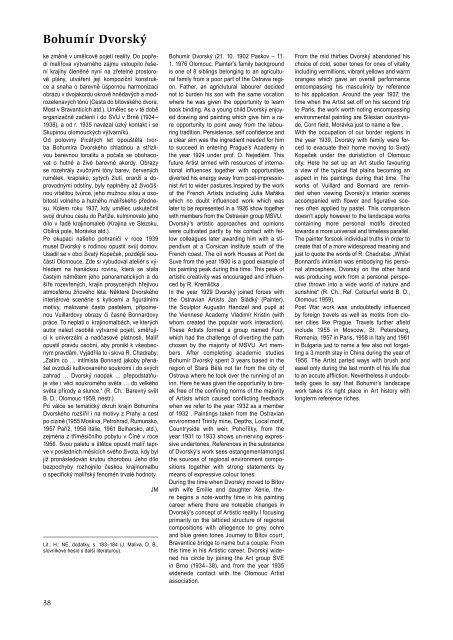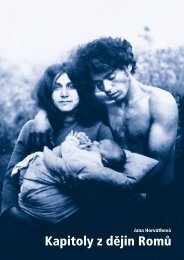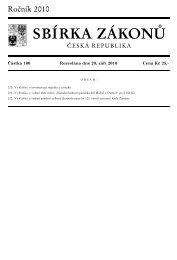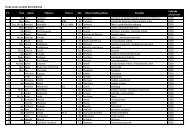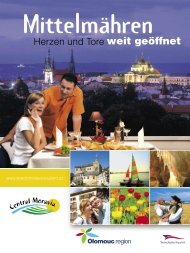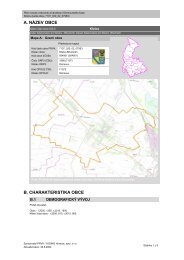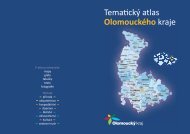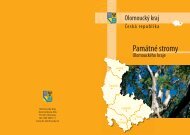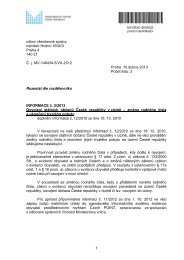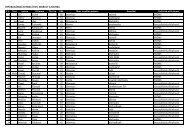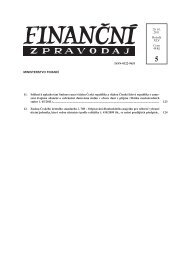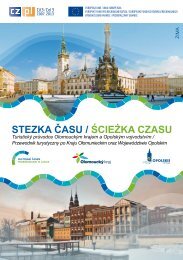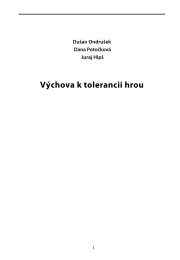Krajina v tvorbÄ umÄlců Olomouckého kraje - Olomoucký kraj
Krajina v tvorbÄ umÄlců Olomouckého kraje - Olomoucký kraj
Krajina v tvorbÄ umÄlců Olomouckého kraje - Olomoucký kraj
Erfolgreiche ePaper selbst erstellen
Machen Sie aus Ihren PDF Publikationen ein blätterbares Flipbook mit unserer einzigartigen Google optimierten e-Paper Software.
Bohumír Dvorskýke změně v umělcově pojetí reality. Do popředímalířova výtvarného zájmu vstoupilo řešení<strong>kraj</strong>iny členěné nyní na zřetelné prostorovéplány, utváření její kompoziční konstrukcea snaha o barevně úspornou harmonizaciobrazu v dvojakordu okrově hnědavých a modrozelenavýchtónů (Cesta do bítovského dvora,Most v Bravanticích atd.). Umělec se v té doběorganizačně začlenil i do SVU v Brně (1934–1938), a od r. 1935 navázal úzký kontakt i seSkupinou olomouckých výtvarníků.Od poloviny třicátých let opouštěla tvorbaBohumíra Dvorského chladnou a střízlivoubarevnou tonalitu a počala se obohacovato hutné a živé barevné akordy. Obrazyse rozehrály zvučnými tóny barev, červenýchrumělek, kraplaků, sytých žlutí, oranží a doprovodnýmiodstíny, byly naplněny až živočišnouvitalitou tvůrce, jeho mužnou sílou a osobitostívolného a hutného malířského přednesu.Kolem roku 1937, kdy umělec uskutečnilsvojí druhou cestu do Paříže, kulminovalo jehodílo v řadě <strong>kraj</strong>inomaleb (<strong>Krajina</strong> ve Slezsku,Obilná pole, Morávka atd.).Po okupaci našeho pohraničí v roce 1939musel Dvorský s rodinou opustit svůj domov.Usadil se v obci Svatý Kopeček, pozdější součástíOlomouce. Zde si vybudoval ateliér s výhledemna hanáckou rovinu, která se stalačastým námětem jeho panoramatických a došíře rozevřených, <strong>kraj</strong>in prosycených hřejivouatmosférou žňového léta. Některé Dvorskéhointeriérové scenérie s kyticemi a figurálnímimotivy, malované často pastelem, připomenouVuillardovy obrazy či časné Bonnardovypráce. To neplatí o <strong>kraj</strong>inomalbách, ve kterýchautor nalezl osobité výtvarné pojetí, směřujícík univerzální a nadčasové platnosti. Malířopustil pravdu osobní, aby pronikl k všeobecnýmpravdám. Vyjádřila to i slova R. Chadraby:„Zatím co … intimista Bonnard jakoby přenášelovzduší kultivovaného soukromí i do svýchzahrad … Dvorský naopak … přepodstatňujevše i věci soukromého světa … do velkéhosvěta přírody a slunce.“ (R. Ch.: Barevný světB. D., Olomouc 1959, nestr.).Po válce se tematický okruh <strong>kraj</strong>in BohumíraDvorského rozšířil i na motivy z Prahy a cestpo cizině (1955 Moskva, Petrohrad, Rumunsko,1957 Paříž, 1958 Itálie, 1961 Bulharsko, atd.),zejména z tříměsíčního pobytu v Číně v roce1956. Svou paletu a štětce opustil malíř teprvev posledních měsících svého života, kdy byljiž pronásledován krutou chorobou. Jeho dílobezpochyby rozhojnilo českou <strong>kraj</strong>inomalbuo specifický malířský fenomén trvalé hodnoty.JMLit.: H.: NE, dodatky, s. 183–184 (J. Maliva, D. B.,slovníkové heslo s další literaturou).Bohumír Dvorský (21. 10. 1902 Paskov – 11.1. 1976 Olomouc. Painter’s family backgroundis one of 8 siblings belonging to an agriculturalfamily from a poor part of the Ostrava region.Father, an agriclutural labourer decidednot to burden his son with the same vocationwhere he was given the opportunity to learnbook binding. As a young child Dvorský enjoyeddrawing and painting which give him a rareopportunity to point away from the labouringtradition. Persistence, self confidence anda clear aim was the ingredient needed for himto succeed in entering Prague’s Academy inthe year 1924 under prof. O. Nejedlém. Thisfuture Artist armed with resources of internationalinfluences together with opportunitiesdiverted his energy away from post-impressionistArt to wider pastures.Inspired by the workof the French Artists including Julia Mařákawhich no doubt influenced work which waslater to be represented in a 1926 show togetherwith members from the Ostravian group MSVU.Dvorský’s artistic approaches and opinionswere cultivated partly by his contact with fellowcolleagues later awarding him with a stipendiumat a Corsican institute south of theFrench coast. The oil work Houses at Pont deSuve from the year 1930 is a good example ofhis painting peak during this time. This peak ofartistic creativity was encouraged and influencedby R. Kremlička .In the year 1929 Dvorský joined forces withthe Ostravian Artists Jan Sládký (Painter),the Sculptor Augustin Handzel and pupil atthe Viennese Academy Vladimír Kristin (withwhom created the popular work interaction).These Artists formed a group named Four,which had the challenge of diverting the pathchosen by the majority of MSVU. Art members.After completing academic studiesBohumír Dvorský spent 3 years based in theregion of Stará Bělá not far from the city ofOstrava where he took over the running of aninn. Here he was given the opportunity to breakfree of the confining norms of the majorityof Artists which caused conflicting feedbackwhen we refer to the year 1932 as a memberof 1932 . Paintings taken from the Ostravianenvironment Trinity mine, Depths, Local motif,Countryside with weir, Pohořílky, from theyear 1931 to 1933 shows un-nerving expressiveundertones. References in the substanceof Dvorský’s work sees estangementamongstthe sources of regional environment compositionstogether with strong statements bymeans of expressive colour tones.During the time when Dvorský moved to Bítovwith wife Emílie and daughter Xénie, therebegins a note-worthy time in his paintingcareer where there are noteable changes inDvorský’s concept of Artistic reality I focusingprimarily on the latticed structure of regionalcompositions with alliegence to grey ochreand blue green tones Journey to Bítov court,Bravantice bridge to name but a couple. Fromthis time in his Artistic career, Dvorský widenedhis circle by joining the Art group SVEin Brno (1934–38), and from the year 1935widenede contact with the Olomouc Artistassociation.From the mid thirties Dvorský abandoned hischoice of cold, sober tones for ones of vitalityincluding vermillions, vibrant yellows and warmoranges which gave an overall performanceemcompassing his masculinity by referenceto his application. Around the year 1937, thetime when the Artist set off on his second tripto Paris, the work worth noting encompassingenvironmental painting are Silesian countryside,Corn field, Morávka just to name a few .With the occupation of our border regions inthe year 1939, Dvorský with family were forcedto evacuate their home moving to SvatýKopeček under the duristiction of Olomouccity. Here he set up an Art studio favouringa view of the typical flat plains becoming anaspect in his paintings during that time. Theworks of Vuillard and Bonnard are remindedwhen viewing Dvorský’s interior scenesaccompanied with flower and figurative scenesoften applied by pastel. This comparisondoesn’t apply however to the landscape workscontaining more personal motifs directedtowards a more universal and timeless parallel.The painter forsook individual truths in order tocreate that of a more widespread meaning andjust to quote the words of R. Chadraba: „WhilstBonnard’s intimism was embodying his personalatmosphere, Dvorský on the other handwas producing work from a personal perspectivethrown into a wide world of nature andsunshine“ (R. Ch.: Ref. Colourful world B. D.,Olomouc 1959).Post War work was undoubtedly influencedby foreign travels as well as motits from closercities like Prague. Travels further afieldinclude 1955 in Moscow, St. Petersberg,Romania, 1957 in Paris, 1958 in Italy and 1961in Bulgaria just to name a few also not forgettinga 3 month stay in China during the year of1956. The Artist parted ways with brush andeasel only during the last month of his life dueto an accute affliction. Nevertheless it undoubtedlygoes to say that Bohumír’s landscapework takes it’s right place in Art history withlongterm reference riches.38


